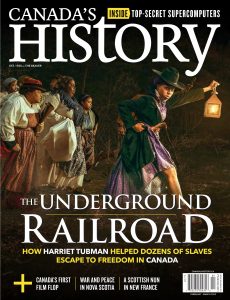
Canada’s History – February-March 2022
English | 70 pages | pdf | 13.73 MB
Slavery has existed as a stain on humanity since the very beginnings of civilization.
It also underpinned much of the economic development of parts of early North America, especially in what’s today the southern United States. Most Canadians are familiar with the broad strokes story of industrialized slavery: Beginning in the sixteenth century, a vast and cruel cross-Atlantic slave trade emerged that saw millions of Africans captured and transported across the ocean to the New World, where they were forced to harvest raw materials to supply the lucrative manufacturing enterprises of Europeans. Fewer Canadians likely realize that the British and French colonies that eventually became Ontario, Quebec, and the Maritime provinces also practised slavery. For instance, French records from around the mid-1750s indicate that as many as 3,600 Indigenous and Black people lived in slavery in New France. Canada also played a prominent role in helping to end the vile practice. In 1793, the lieutenant-governor of
Upper Canada proposed the first law in the British Empire to restrict slavery. A decade and a half later, Britain formally banned the buying or selling of humans
throughout its empire. Around this time, a courageous movement began to take shape — one that today we know as the Underground Railroad. It began in the early 1800s as a loose network of volunteers — both Black and white — who were united by the singular goal of freeing people from slavery.
Creating safe houses and operating in secret, members of the Underground Railroad worked tirelessly to help tens of thousands of enslaved people find freedom in Canada and the northern United States.
In this issue, writer Nancy Payne recalls the life of one of the towering figures of the Underground Railroad — Harriet Tubman, who, from her home in St. Catharines, in present-day Ontario, orchestrated the escapes of dozens of American slaves.
Elsewhere in this issue, we recall one of the biggest flops in early Canadian moviemaking, we explore the life of a Scottish nun in New France, and we remember Canadian efforts to create the world’s first wireless computer network.
Download from: